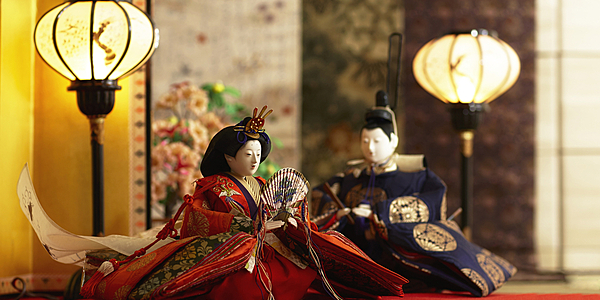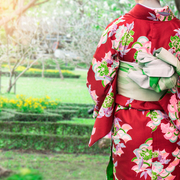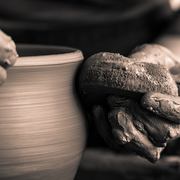Momo-no-Sekku (Peach Festival) on Match 3rd, also known as Hina-matsuri (Doll’s Festival), is a festival to pray for healthy growth and happiness of girls displaying Hina-ningyo (Hina dolls) generally.
A decade ago, a big family displayed Hina dolls on 5-7 steps (Hinadan) at its own house.
The male Odairisama and female Ohinasama are set at the top step, and the Sannin-kanjo (three court ladies) and Gonin-bayashi (five musicians) are arranged on lower steps, which creates luxury atmosphere.
Nowadays, the number of nuclear families has increased and the less families prepared for a large-scale gorgeous Hina-ningyo like before.
The Hina-ningyo with around 3 steps are major and Displaying only the Odairisama and Ohinasama on the flat stage is popular.
Thus, the Hina-ningyo have changed over time. Then, how were the Hina-ningyo created and did the custom of displaying the Hina-ningyo begin?
Let’s see the beginning of the Hina-ningyo, its history, its meanings, and the etiquette of displaying.

The Beginning and History of Hina-ningyo
First of all, let’s walk through the beginning and history of the Hina-ningyo (Hina dolls).
In Japan, there is a calendar made from the basis of the Onmyo-gogyo-setsu* introduced from China.
On the calendar, five “Sekku”, which is a day which marks a traditional event.
*Onmyo-gogyo-setsu introduced from China: The theory that combines the Onmyo-setsu that all things exist can be divided into yin and yang, which is inseparable and contradictory opposites, and the Gogyo-setsu that all things exist consist of the 5 elements of wood, fire, earth, metal, and water.
Five “Sekku” are Jinjitsu on January 7th, Joshi on March 3rd, Tango on May 5th, Shichiseki on July 7th, Choyo on September 9th.
Among those, at the Sekku of Joshi on March 3rd, the custom of getting rid of bad luck for girls by dolls, which was easily available among ordinary people, began in the Heian period.
This ritual was patting a girl’s body by a doll made from straw or grass to transfer impurity of her on its doll and float it down a river to get rid of bad luck.
On the other hand, among girls of the aristocracy, “Hiina-asobi”* using a paper doll was popular, and combining with the purifying custom by dolls on the Sekku of Joshi creates the idea of “Hina-ningyo (Hina dolls)”.
*Hiina-asobi: “Hiina” is the archaic word of “Hina”.
“Hina”, literally referring to a baby bird, means “pretty”.
In the Heian period(794-1185), among girls of the aristocracy, playing house with “Hiina-ningyo”, meaning a small and pretty paper doll, was popular, which was called as “Hiina-asobi”.
The Meaning of Hina-ningyo
Then, why did Hina-ningyo come to be displayed on the Girl’s Festival?
Originally the Sekku of Joshi refers to the early March and did not specify any date, but the Shogunate set the date as March 3rd in the Edo period(1603-1867).
In the past, at the time of Sekku, the court traditionally held a banquet called “Sechie”, but, in the Edo period, the specific date was set for each Sekku to succeed this custom.
At the Sekku of Joshi (Sekku of peach, Hina-matsuri), people display to celebrate the girl’s day.
Likewise, at the Sekku of Tango on May 5th, Koinobori (a carp-shaped streamer) and Kabuto (a miniature samurai warrior helmet) are displayed to celebrate the boy’s day.
Hina-ningyo came from the custom of getting rid of bad luck of girls among ordinary people and “Hiina-asobi” by the aristocracy girls, but at first the dolls were like origami (folding paper)-made.

Gradually, more sophisticatedly made and gorgeous dolls were used and people came to display dolls at home, not float them down a river.
At first, Hina-ningyo and implements were arranged on a carpet laid directly on Tatami, but in the middle of Edo period, Hinadan (steps) came to be used and it has developed to the current style.
Then, the purpose of making dolls have changed from getting rid of impurity which girls had, to praying for healthy growth and happiness of girls.
Thus, Hina-ningyo was regarded as an amulet against disasters upon girls.
This is why there was a time when Hina-ningyo was one of important wedding preparation of women.
When is Hina-ningyo Displayed?
When should you start displaying and putting away Hina-ningyo?
T he Time to Display Hina-ningyo
The time to start displaying Hina-ningyo should be a week before March 3rd or at the end of February at latest to be ready before the Girl’s Festival on March 3rd.
It is recommended to display them on the day of “Taian”, which is the most auspicious day.
On Japanese calendar, there is Rekichu, which indicates fortunes on dates and directions.
Rokuyo, one of the Rekichu, labels each day by 6 words; Sensyo, Tomobiki, Senbu, Butsumetsu, Taian, Shakko, for the reference on deciding a date for ceremonial occasions.
Since Taian is one of the Rokuyo, and is regarded as a lucky day to have celebration, it is good to choose the Taian date to display Hina-ningyo.
If you cannot find any suitable day among lucky dates on Rokuyo, you can pick up a day when family members as many as possible can join to display Hina-ningyo.
T he Time to Put away Hina-ningyo
As for the time to put Hina-ningyo away, it is better to finish it as soon as you can after March 3rd.
It is said that bad luck dolls had taken away for a girl returns to her if Hina-ningyo is kept on display after the Girl’s Festival.
This is why there is a superstition that the delay on putting away causes a girl to miss a marriage opportunity.
Therefore, it is recommended to put Hina-ningyo away 2-3 days after March 3rd, or within a week at latest.
In addition, Hina-ningyo might get damaged with dusts if it is kept on display for long.
Having said that, it is important to avoid a rainy and wet day and to put it away on a fine and dry day as soon as the Girl’s Festival ends.

Conclusion
Originally, Hina-ningyo was created from the basis of a doll which got rid of impurity of girls.
Ohinasama (Hina-ningyo) is admirable because it takes all bad luck and impurity which a girl has, as her clone without knowing it.
Please thank them, clean up, and put them back in a box with great care after displaying Hina-ningyo.

















